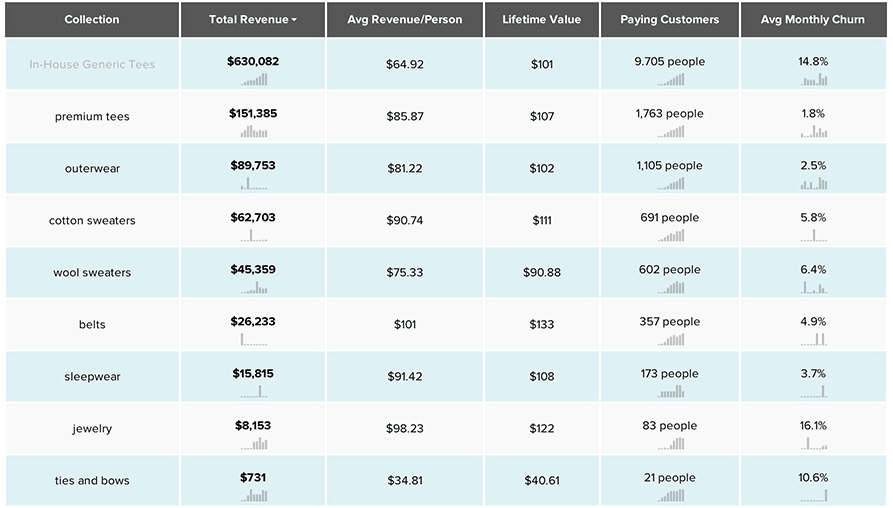Miyerkules, Agosto 31, 2016
Inequality is widening, even in real estate
5 Strategies to Entice Consumers to Binge-Watch Your Product Videos
Continue watching.
These two words are infamous in the world of video streaming. When consumers are hooked, they want more to watch.
“Content marketers should consider the binging trend a sort of case study. All of the elements that make us binge are lessons,” says Kari Matthews, a content writer for technology companies.
“We can do what these [television] shows do, in our own way, in our own industries, to make the most of our content and build our brands.”
Work with your team to engage customers with binge-worthy product videos. Get them excited about your brand and ecommerce services.
Try these five strategies below to entice your consumers.
1. Cater to Diverse Audiences
Normally, experts suggest creating content to serve a select group of people. But when it comes to product videos, you may want to take a different approach.
You want your content to be shareable. So, it must serve several different audiences. And that includes people who will never purchase your product.
“Remember that not everybody who buys, buys today, not everybody who consumes content shares it, and not everybody who shares content buys,” states Scott Allan, chief marketing officer at AddThis.
“Instead of focusing on capturing leads, create memorable content that customers will draw on when they or their friends are ready to make a purchase.”
So, produce content that people can share with their family and friends. Focus on moments that everyone can relate to, like laughing with friends, hosting a summer barbeque, or attending a college football game.
Below is the noteworthy Dollar Shave Club product video. Not everyone who shared this content bought the shavers, but it did go viral and reached their target audience.
If your company wants avoid vulgar language, think of your product video like a PG-rated film. For instance, most Disney movies are meant for kids to enjoy, but they have enough common themes to engage the parent.
Don't be afraid to serve more people with your videos. The goal is to spread the word.
2. Develop A Backstory
For product videos to gain your audience's attention, the content must discuss more than the product. Yes, content must go beyond talking about your company.
In other words: Tell a story that emotionally attaches people. It's all about showing your audience a new perspective. And giving them a different insight that humanizes your brand.
Studies show that “Americans alone consume over 100,000 digital words every single day, but 92% say they want brands to tell stories amongst all those words.”
The same holds true in the world of video. A written product description isn't good enough. And a video regurgitating similar information is just awful.
According to For Dummies, a “backstory refers to everything that occurred in your story's past. A character's backstory may include family background, job history, psychological condition, and any memories you create for that person from childhood on.”
Instead, bring your videos to life with characters and a plot. Give the actors names and set up an environment where the product is being used, not displayed.
That's what Amazon did when they introduced its Echo. Rather than giving consumers a run down of the product features, the eCommerce giant showcased the product's value in a simulated setting.
Get creative. Show, don't just tell consumers about your products.
3. Create Episodic Content
According to Netflix, the network's 83 million members watch more than 125 million hours of TV shows and movies every day. That's a lot of time in front of a screen.
But what keeps viewers coming back for more?
One reason is access to uninterrupted content. Consumers don't need to worry about commercials. Advertisements don't get in the way of their favorite shows. Therefore, they can focus on viewing what they love the most.
Another reason is the addicting show plots. A great television show contains episodes that leave the audience wanting more. People constantly want to know what's going to happen next.
Will the main character finally locate the killer? Or will the antagonist prevail and destroy his enemies?
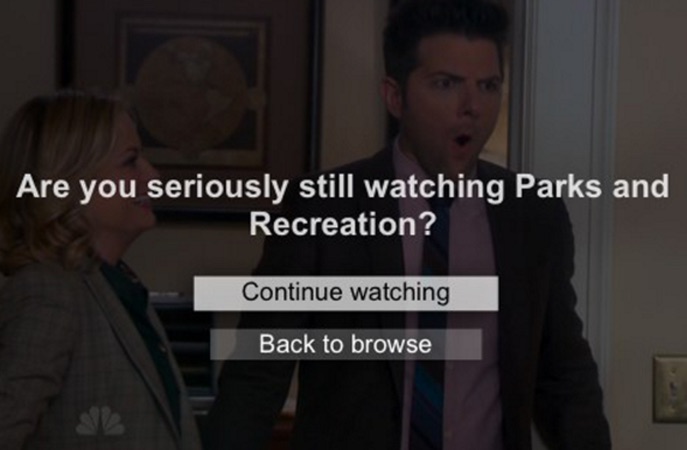
Episodic content has people on the edge of their seats. And that's how your team should set up product videos.
Shoot multiple videos with cliffhangers. Get consumers intrigued about your brand culture and latest product benefits.
“Episodic content enhances the credibility of your brand as people become more and more familiar with you and what you are about. This builds trust and value with your target audience,” says Kerri Ponder, a writer at Crowd Content.
One product video is fine. But a bunch can get customers hooked on your ecommerce brand.
4. Notify Customers of Updates
Your customers are busy. They have to manage both their work and home schedules.
So, sometimes certain things get forgotten. And that's perfectly fine.
That's where are your team steps in. Remind your customers of your new product videos.
There's an old marketing adage: The Rule of Seven. It says that a “prospect needs to see or hear your marketing message at least seven times before they take action and buy from you.”
Create a special website pop-up telling them about new videos. Keep customers informed by sending notification emails leading up to the launch.
Your business already sends updates about new terms and conditions. Mimic the technique for product videos.
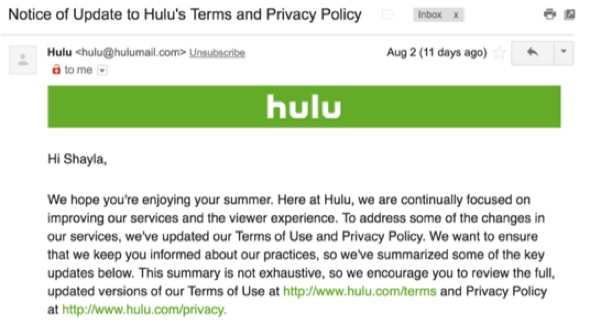
“Getting people excited about content that is perhaps not yet fully done whets their appetite and keeps them talking about you and your brand, days ahead of when your campaign or content actually is released,” writes Shanna Cook, senior social media manager at Nokia.
Like any marketing tactic, don't over do it. Reminders can become nuisances if they are sent every single day. Take a look at your internal data and set times best suited for your target audience.
Ask customers to sign up for your email list for product video announcements. There's power in notifications.
5. Offer an Instant Reward
Everyone enjoys special gifts for their efforts. Reward customers for taking the time to watch or share your video.
Customers want to be delighted. They desire instant rewards that help them today, not tomorrow. So, stay away from mail-in rebates or points that can't be redeemed today.
For example, at the end of a product video, offer a 10% promo code. And think beyond discounts. Give away exclusive access to a webinar or a free eBook.
Christian Karasiewicz, a social media marketing professional, suggests the following:
“Develop a video to showcase your expertise or further educate your viewers, then include a YouTube card that leads your audience to related material. This can be a transcription, checklist, infographic, SlideShare or downloadable PDF…”
YouTube cards are notifications that appear in your video. It's a small rectangular box at the top right corner. It gives your viewers a preview of the message. Check out the video below on how to add cards to YouTube videos.
Analyze which rewards consumers like the most. Then, start offering instant rewards for watching your product videos.
Binge-Worthy Content
On-demand video is attracting consumers to brands. The best ones hold the audience's attention and keep them engaged.
Aim to create product videos for a diverse audience. Give your videos a backstory. And notify customers of new releases.
Produce captivating product videos. Let consumers continue watching.
About the Author: Shayla Price lives at the intersection of digital marketing, technology and social responsibility. Connect with her on Twitter @shaylaprice.
Martes, Agosto 30, 2016
7 Reasons Your Site Isn't Ready for A/B Testing
You've invested a lot of time and effort into perfecting your website and you want to get the maximum return from that investment. To achieve that goal, you've studied dozens of blogs on conversion optimization techniques. You've poured over countless CRO case studies, and you have a few tools to help you run A/B tests.
Before you start split testing to get those conversion gains, pause for a second. I don't think you're quite ready yet.
There are plenty of free tools to help you test your optimization – not to mention paid options from Optimizely to OptinMonster that'll help you explore different facets of your site's performance – so just about anyone can run A/B tests. But it's not a matter of simply understanding how to do it.
The problem is that your site just isn't there yet. A/B testing isn't for everyone, and if it's not done at the right time with the right conditions, you might end up accumulating a lot of false data that does more harm than good. Before you invest anything in testing and extensive optimization, consider these seven points:
1. The Traffic Volume Isn't There

There's no doubt that A/B testing can be highly useful for businesses that want to improve their conversion rates. Having said that however, a lot of businesses shouldn't bother with A/B testing.
Small businesses that are trying to grow, startups, e-commerce businesses in their early years and other micro businesses simply don't have the traffic and transactions to accurately perform A/B tests. It takes a significant amount of traffic to provide accurate, measurable results.
In a post from Peep Laja of ConversionXL, he provided an example using a sample size calculator from Evan Miller, where the baseline conversion rate is entered. He then entered the desired lift.
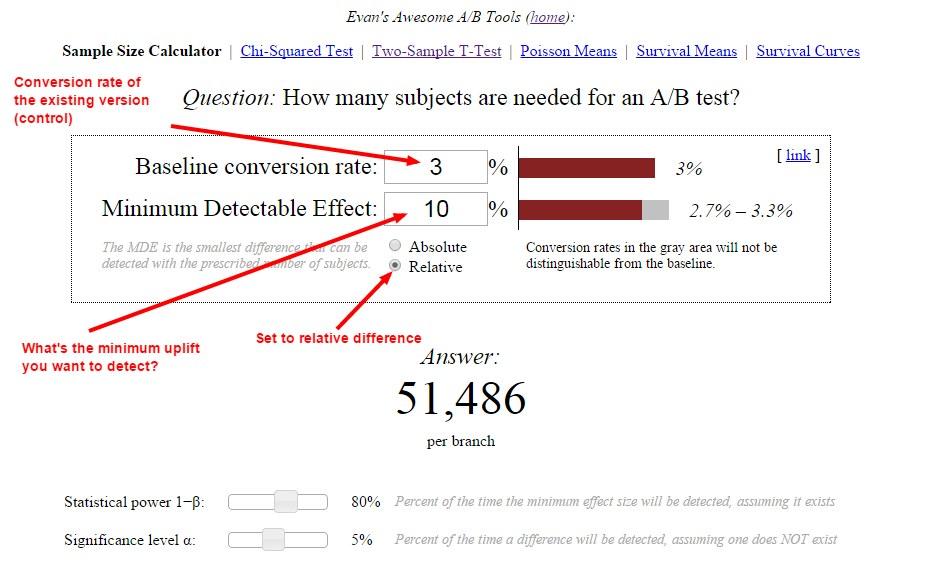
You can see from this image that in order to detect a 10% lift, the tool recommends at least 51,486 visitors per variation.
If the traffic isn't there yet, you can still optimize your site based on audience data you've gathered, but A/B tests won't be helpful for a while and they might produce false information.
2. You Don't Have Anything to Test
A lot of websites function as a general brochure for a company with minimal conversion points. If you run a B2B site or you have a freshly-created site with little more than a contact form and an opt-in, then it's too early in the game to start running concurrent A/B tests.
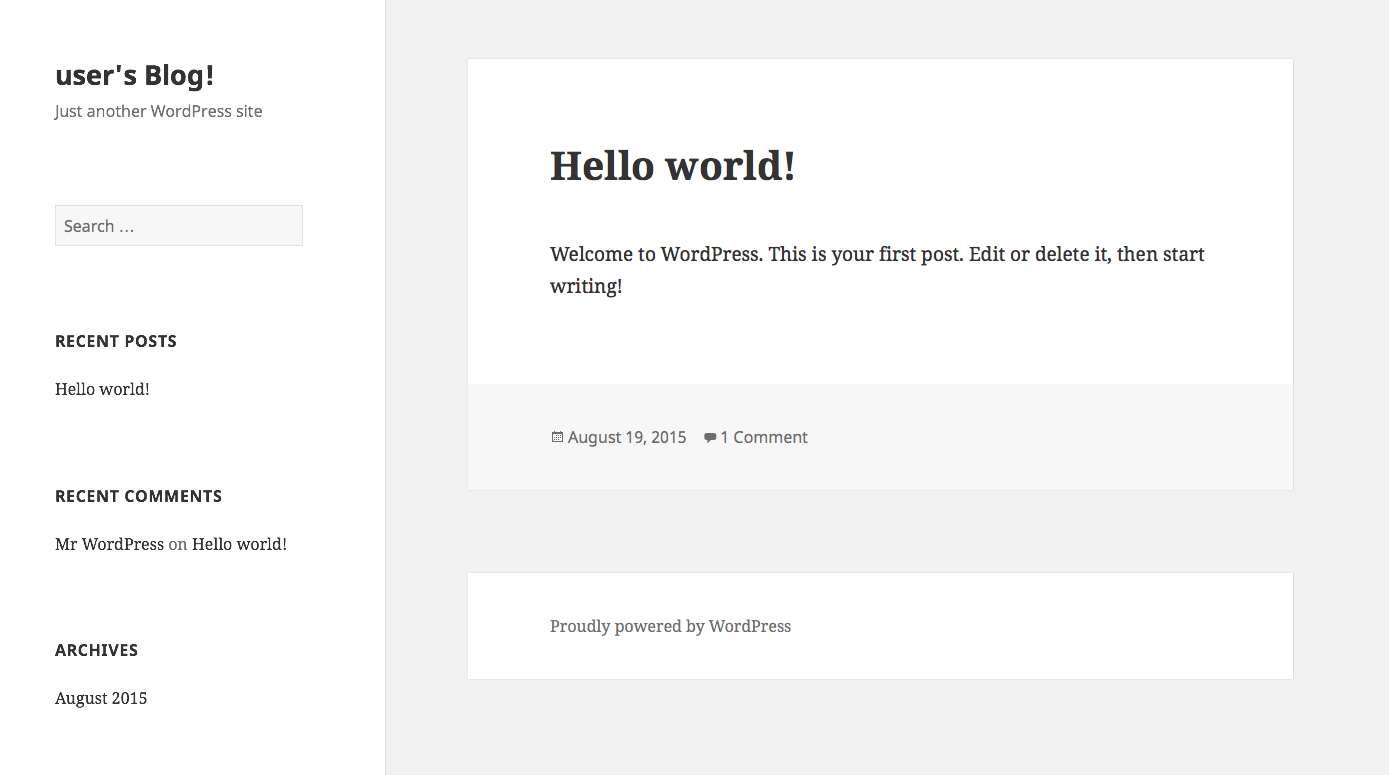
Even if the volume of traffic is adequate to run accurate tests, you may not see a significant lift from a general opt-in or estimate request form. For most businesses, the amount of effort and cost that would go into designing variations for the tests just to get a small lift around micro conversions isn't worth it.
The same applies to newer e-commerce stores.
Your time would be better spent with your analytics, where you can set up goal tracking, creating marketing campaigns, and developing your content offers and resources. The A/B testing can come later once you have more to offer and traffic has grown substantially.
3. You're Not Sure What Matters
Do you know what the choke points, leaks, and sticking points are in your funnel? I'm referring to the places where you're losing prospective customers, as well as where you're gaining the most.
Before you can run any kind of tests, you have to understand what matters, because some elements are more important than others.
For example: a marketing agency is driving visitors to their estimate request page. They spend a significant amount of time optimizing that page with A/B testing variations and micro changes. After extensive testing, they find that their efforts made very little difference with virtually no impact on their conversions.
Instead, they should have looked for mistakes in their funnel leading up to that page. Maybe the content that led the visitor to that point was where the changes needed to be made. Maybe the search intent of the customer didn't match the content they found.
Another example: a brand selling shoes online puts a great deal of effort into optimizing and testing product pages, only to realize that the lift in conversion was insignificant. Instead, they could find ways to improve the average order value or review their funnel in Kissmetrics to find the biggest leaks where customers are dropping off and fix those problems instead.
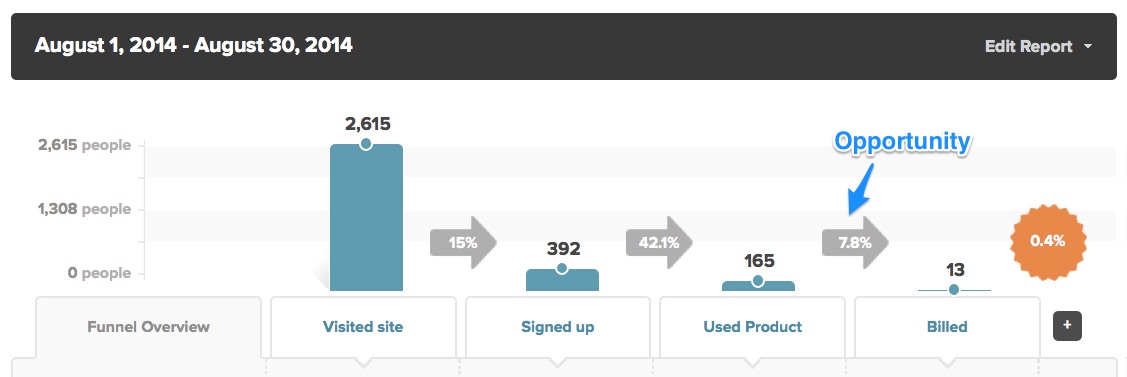
If you randomly try to test what you think matters, then you'll only be wasting time.
One study from Forrester showed that 60% of firms surveyed saw improvements in their website when they used a data-driven approach to design. It's important to take the time to research what really matters to your business so you know what to optimize and where to make changes.
4. You're Copying Content
While a competitor site (or any site for that matter) might look like an attractive design that your customers will probably engage with, you can't waste time testing if you've played copycat.
Any tests you run after replicating their design and content will only be wasted. If the solution was as simple as copying what we thought worked well for our competitors (or even conversion case studies) then every e-commerce website would function exactly like Amazon.
The fact is, websites are highly contextual and they should relate to both the audience and what you're promoting. Wal-Mart and Whole Foods are in the same business of selling food products, but they cater to completely different audiences and sell vastly different products.
If I stacked up my own services against another marketing agency offering identical services, there would still be contextual differences in how we market, how we service customers, the channels we use to engage them, and how we direct traffic to our sites.
You need to make sure your website is designed specifically for you, your channels, your audience, etc. before investing in testing.
5. The Data Isn't There
The more capable you are with analytics tools like Kissmetrics or Google Analytics, the better off you'll be. But, if the extent of your knowledge consists of checking traffic quantities, referral sources, time on page and bounce rates, then you're only scraping the surface.

You have to approach your testing and analytics with a problem so you can find an answer in the data. That way, you can identify issues and confirm what aspects you need to change.
Learning a bit more about your analytics can tune you into:
- How site elements or offers are performing
- How your content is performing and whether it is keeping people engaged
- What people are doing on your site and the routes they typically take
- Where people are landing, as well as where they're leaving
- Where your funnel is losing money
The data won't specifically tell you how to fix problems; it's just a starting point where you can discover actionable insights. Without that data, and without the ability to interpret it, A/B testing is pointless.
6. Your Site Has Usability Issues
When was the last time you tested your website in a browser other than the one you typically use? Have you tried going through your entire site on a mobile device?
Have you ever performed a full usability test with a variety of browsers and devices?
This is something a lot of marketers don't consider when they start A/B tests. Ignoring usability issues, tech problems, and bugs is a huge mistake, though. Even minor bugs and slow load times can dramatically impact your conversion rates.
Just a one second delay in load time can drop conversion rates by as much as 7%.
You won't get accurate results from A/B testing if segments of your audience are bailing due to usability issues. Some of your audience may never make it to your conversion point, and even if they do, their progress could be hindered by bugs or load times that will ultimately skew your results.
This misinterpretation could lead to changes and further variations of elements that are actually part of your winning, optimized design.
7. You Don't Know Your Audience
Audience research should be one of the first steps of any marketing strategy. If your goal is to drive lots of traffic to your site with content marketing and paid advertising, I would hope you've done some measure of audience research.
Without it, you're shooting blindly into the darkness and hoping to score a bullseye.
Researching and defining your target audience gives you in-depth information about who you're targeting, such as their pain points, interests, behaviors, demographics info, and more. That information helps you craft compelling copy, winning headlines, and attention-grabbing offers.
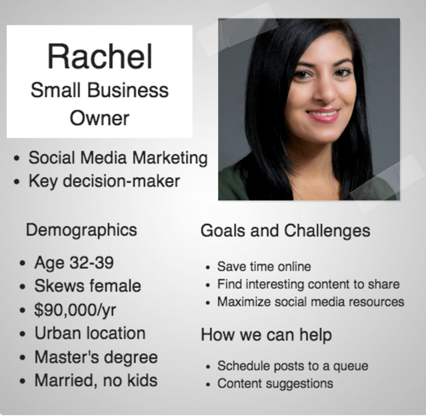
Without it, you'll resort to guessing what to change about your copy, headlines, offers, and calls-to-action. Every variation you test will be just as random as the one before it, and you likely won't see any significant change in performance.
Know who you're marketing to before you make a large investment in A/B testing.
Testing isn't for Everyone
While there's a wealth of articles and advice online telling you test everything you do and to A/B test every variation, you don't have to. For many statups and growing online businesses there just isn't enough traffic early on to create an accurate sampling with measurable results.
Focus on growing your business for now. As you grow traffic levels, learn more about your customers, and targeted traffic increases you can start testing variations to go after those micro wins.
Do you use A/B testing on your site or landing pages right now? Have you found issues with the quality of your results? Share your thoughts with me in the comments below.
About the Author: Aaron Agius is an experienced search, content and social marketer. He has worked with some of the world's largest and most recognized brands to build their online presence. See more from Aaron at Louder Online, their Blog, Facebook, Twitter, Google+ and LinkedIn.
Commercial Real Estate Market Trends Update: August 2016
George Ratiu, Director of Quantitative and Commercial Research, and Stephanie Spear, Commercial Regulatory Policy Representative, provide an update on the commercial real estate market trends for the 2nd Quarter.
Lunes, Agosto 29, 2016
Leaking Leads? Here's How to Plug Your Analytics Gaps
Full funnel attribution is the dream.
A pipe dream.
In most cases.
Because a majority of the time, you're nowhere close.
Campaigns are tagged. Sometimes.
You track incoming calls. Like 5% of the time.
You've got lead reports. Which go up-and-to-the-right at least.
It ain't your fault. Our tools are limited. Cross-department assistance tricky. And marketing channels exploding.
So here's a simple process to help you take back control, hopefully eliminating all of those little gaps where leads commonly leak out of your funnel and mess up your reporting efforts.
The Great Analytics Gap: Where Exactly Are Your Paying Customers Coming From?
How many leads did you get this month from Twitter?
How about email?
Most likely, those numbers are wrong.
Not because you made a mistake. But because your analytics platform did.
See, most basic analytics programs like Google Analytics are good. But not smart. (They're also free, so we can't complain too much.)
For example, your Email and Social leads this month are probably understated (only getting credit for a fraction of their overall performance), while your Direct ones are overstated (getting more credit than they really deserve).
Sometimes the swing can be 60%!
If campaigns aren't tagged properly (and let's be honest, who tags Tweets with any regularity), analytics programs will have a tough time picking up the referral source. Especially if these visits originate from desktop programs like Tweetdeck (does that still exist?) or Outlook (which you're probably forced against your will to use).
These are tiny examples, but the problem persists.
Even when you're tracking conversions, with monthly reports going to bosses and clients highlighting Goals with the sources that drove them, you might only be seeing a tiny slice of the overall pie.
Just recently, I've seen multiple clients spending tens of thousands of dollars on ads each month, going off of surface level information.
The phone rings, which is great. But why those calls are coming in is anyone's guess. And nobody has a clue how many paying customers or revenue is tied back to the initial spending efforts.
Think about that. Organizations spending a majority of their marketing budgets on a single channel with tracking… kinda, sorta, setup. But not really.
Couple this with the fact that most smaller organizations use 'niche, industry' tools like legacy proprietary CRM's that offer ZERO API's and absolutely no integration possibilities.
So they're forced to cobble this stuff together, manually.
If this stuff was being tracked properly, you'd almost instantly be able to:
- Save money on the losing campaigns that aren't performing.
- Increase revenue by spending more on those that are.
And then you get a promotion. Or a raise, at least.
Fortunately there are a few techniques you can use to help shed more transparency and accuracy into your analytics. They're not all encompassing, but they're relatively easy adjustments to set up to help you practically solve this problem once and for all.
Click Tracking: The Basics of Campaign (or UTM) Tagging
I already know what you're thinking.
UTM codes blah blah blah. Use any number of builders like the Google URL Builder to drop your URL in and idiot-proof your results.
Obvious.
But here's the thing.
Many times UTM codes aren't used properly. Or aren't used holistically as a way to measure channel performance for conversions.
So let's look at it more practically, organizing campaigns properly to make sure we're tracking almost every single possible use case that might not get picked up by our analytics programs.
The easiest way to accomplish this campaign-wide approach is through inbound traffic segmentation. Which is shorthand* for, “Create a ton of landing page versions & funnels for each traffic source so you're able to clearly see how and where click-conversions are coming from, thereby making analytics and reporting simple”. (*Not really.)
And while there is no shortage of tools to do this stuff for you, we still like to manage client campaigns in a simple, collaborative Google doc so everyone can quickly edit and update.

You can also do the same thing for social channels too, breaking it down even further into the primary ones you choose to plan your campaign's content and messaging strategy ahead of time.

All of this time-consuming, upfront work will eventually pay dividends by making funnel analysis a breeze.
(Brilliant segue coming…) You know what also makes funnel analysis a breeze?
Kissmetrics does this with a visualized funnel reporting tool that can help you analyze all of this raw data and make faster (not to mention, more accurate) marketing decisions.
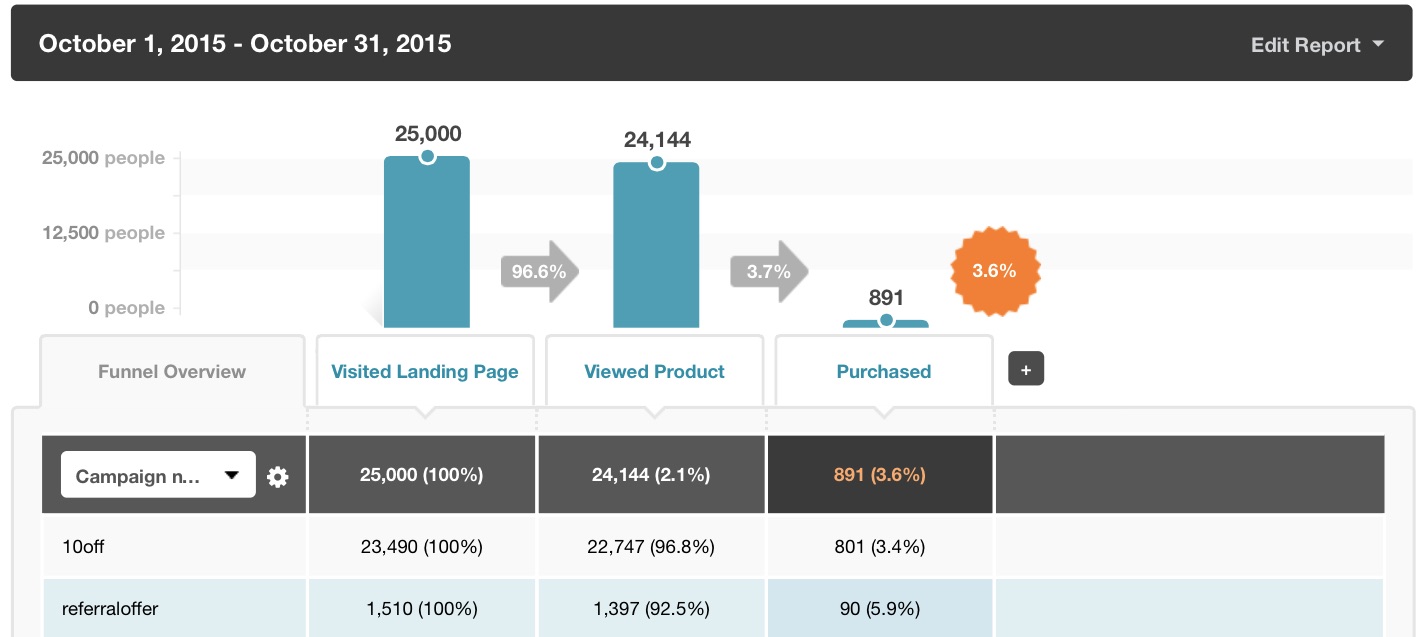
Call Tracking: Gain Insight into Inbound Lead Sessions
Any lead-based company will tell you that good, old-fashioned inbound phone calls are still the best.
Invoca analyzed more than 30 million phone calls and found that they have 30-50% conversion rates (compared to only 1-2% for clicks).
That same study found that 70% of calls are coming from digital channels. And yet, we don't know where.
Or why. As in, what did you do to drive those people to call in the first place? (So you can easily do more of it and take home a nice bonus this year.)
Setting up unique phone numbers on each advertisement or sales collateral is an obvious first step. Duh – your AdWords campaigns are undoubtedly already using phone call tracking.
But…
What happens when those people click to your website instead of calling right away?
Especially if we're talking any type of consultative sale, they're going to click around your site for a bit. Maybe even leave, and come back, several times before pulling the proverbial trigger on someone to work with.
The first step towards limiting the amount of information you don't know is to setup dynamic call tracking that focuses on individual customers.
This way, you're accounting for the multi-device, multi-event, and multi-channel journey (that already happens over half the time).
CallRail is one of my new favorites to do this. You're able to create a pool of phone numbers based on the average amount of real-time website visitors you get.
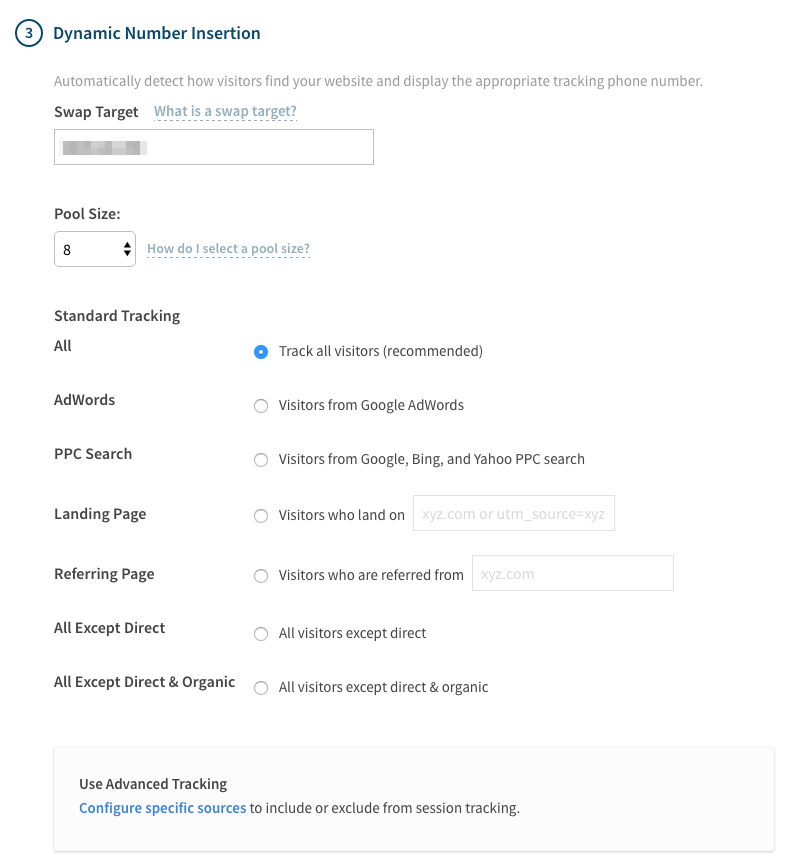
These dynamic phone numbers will substitute the primary one already on your website pages, and automatically stick with one website visitor while they browse around all of your pages.
Not only can you then see a complete web session history, but also start tracking multiple sessions over time from the same customers.
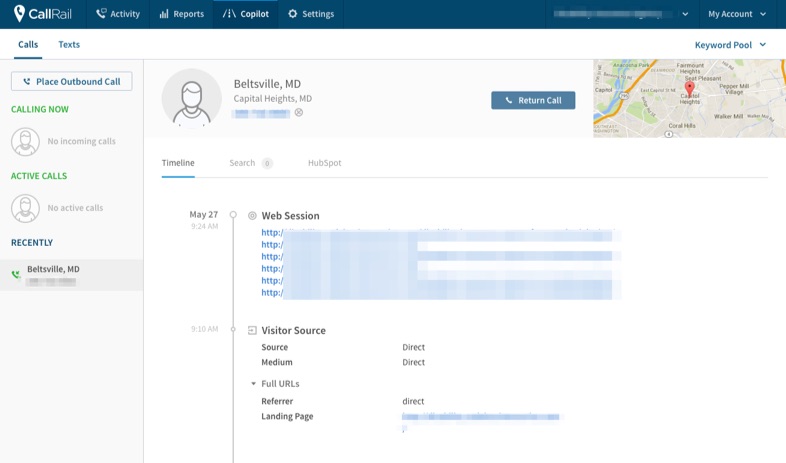
That extra insight gets you one tiny step closer to being able to close out the big black hole that is your offline phone conversions.
There's also a CallRail and Kissmetrics integration to help you better understand how offline phone calls fit into the customer's website and app activity, email engagement and more. You'll also be able to analyze how phone calls play a broader role in lifetime value of a customer (comparing with those who don't call) and see which specific activities they complete immediately before or just after each call.
But before we can run off to implement, there's still one last thing to figure out.
How to match all of this stuff up with your lead and customer data to see where buyers (not leads) are coming from.
Lead Tracking: Determining Which Leads Are Converting
It's time to bring it home.
You've got basic campaign tagging properly organized, to limit the number of sessions that slip through your analytics cracks. And you've set-up dynamic call tracking to monitor people who may visit your site or call your offices multiple times prior to purchase.
Now we need to line that data up with your lead database.
My completely biased opinion is that HubSpot is one of the best solutions for this problem. Which is no surprise, given my company is a HubSpot partner who receives a nice bonus check every time we sign you up. :)
But what if you didn't appreciate the blatant, selfish sales pitch? Or have the extra budget available? Or you just use some other CRM?
Another (albeit, more manual) solution is to use the excellent (and free) LeadIn to begin turning form submissions into actual people.
Once setup, you can integrate this with a few basic email-marketing services to go freaking nuts on hacking your marketing stack.
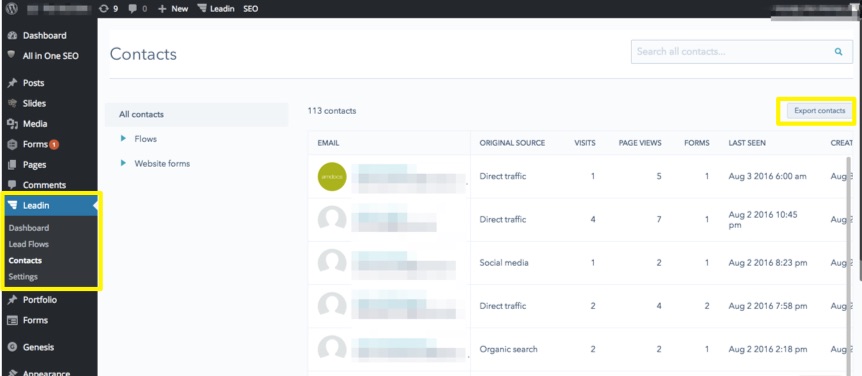
You can also begin exporting this data (I know, who the F-exports manual data anymore) and matching it up with whatever lead-based CRM you use – no matter whether they provide integrations or not.
Ideally, you need to know that John Smith just signed up with your company for $X. And John Smith came from a phone call, through AdWords, targeting the term Y.
In aggregate, a tool like Kissmetrics (surprise!) can then connect all of these dots, finally aligning paying customers (and revenue) back to the marketing channels (and decisions), which generated each.
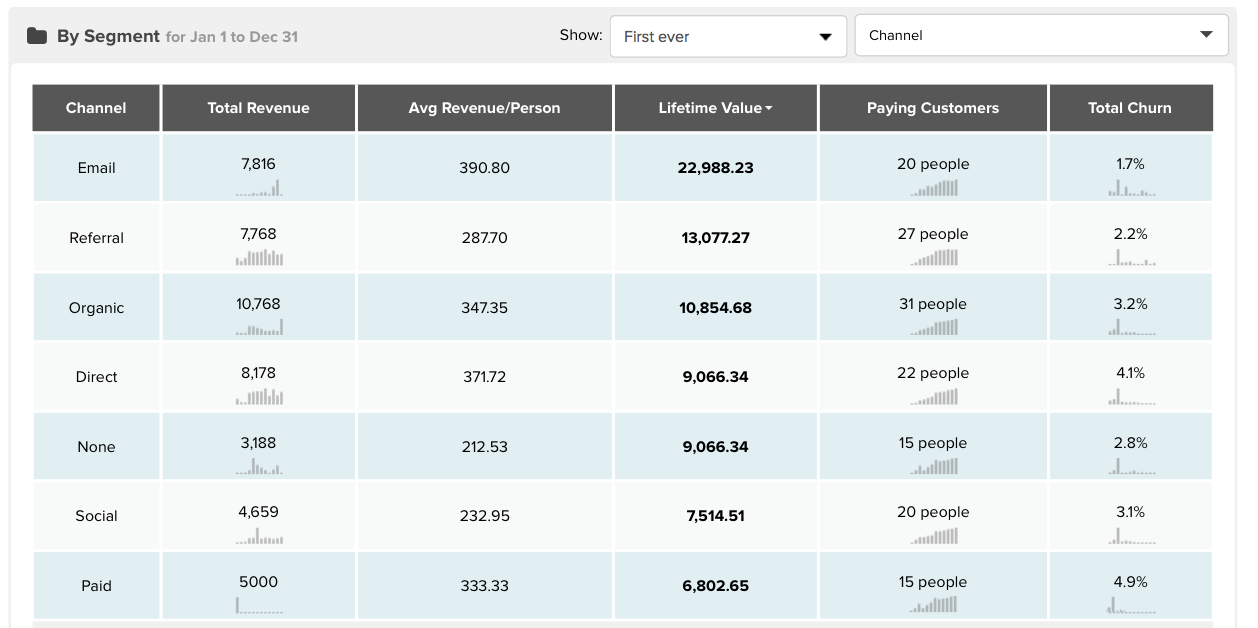
Conclusion
Most of us are making decisions based on incomplete information.
That's life.
The analytics gap problem is only made worse when companies commonly have their own legacy tools that don't play nice with whatever marketing ones you're using.
But when clients and bosses are putting LOTS of money on the line, it's up to us to make bold decisions on how or where to best spend it.
That becomes exponentially easier once you set up proper click tracking for the common online channels people are using once they see, hear or read about your latest campaign. And buttoning-up offline conversions like phone calls can help you finally see how many of those leads you're collecting are transforming into paying customers.
The tips here might not be a perfect solution.
But they can get you significantly closer than where you probably are now.
About the Author: Brad Smith is a founding partner at Codeless Interactive, a digital agency specializing in creating personalized customer experiences. Brad's blog also features more marketing thoughts, opinions and the occasional insight.
Biyernes, Agosto 26, 2016
From Campaigns to Conversions – How to Make Sense of the Data You're Presented With
It's the question on every marketer's mind – “How do we turn these impressions, clicks and conversions into something that drives results for our company?”
The fact is, you have a lot on your plate. From new product launches to generating interest to reaching new markets and paying attention to customer sentiment, there's a lot to juggle. Being able to not just make sense of the data you're gathering, but also turn that information into actionable insights is a must-have skill in today's competitive markets.
The good news is, it can be learned – easily.
The Problem with Reach

In many cases, campaigns are founded with the wrong goal in mind. Everything is measured in “reach”. We look at impressions as the de facto measurement standard when it barely scratches the surface of measuring a consumer's true interest and intent.
The end result, when focusing too much on reach and impressions, is that you might make a boatload of sales, but not be able to map them definitively to any specific campaign or strategy. Even if people first hear about your product through traditional media (TV, print, newspaper), they're very likely to go online and do some more research – and that's where things like reviews, ratings and testimonials can make a significant impact.
Another issue is that most advertising programs assume a straight path to conversions, when the result is anything but. The customer could go from print awareness to online research at your website, but then go offsite to look up user reviews, do some comparison shopping, seek out coupons, watch a product unboxing video, look over the company's Facebook page to see what people are saying, double-back on the comparison shopping engine to find the best deal, and so forth.
The fact is, the conversion path isn't pretty and that's because it's too often tied to wisps of numbers that don't make any meaningful and measurable impact on the bottom line.
Mapping Campaigns to Results

So how do you tie your campaigns into the kind of insights that deliver the results you need? Let's take a look at some common types of campaigns and how they can be adjusted:
E-Commerce Sales
E-Commerce relies heavily on the power of reviews, testimonials and coupons – so combining these in a way that makes sense (such as putting reviews of that particular product below the customer's item when they go to view their cart) will help reduce cart abandonment rates and seal the deal.
Automatically adding in a coupon (especially for free shipping) only serves to sweeten the deal, and greatly reduces the risk that the customer will go offsite to search for coupons – and potentially to a competitor.
Don't forget the service after the sale either. Following up to inquire about how the customer likes the product, if they've used it yet or have any questions are crucial for keeping your brand front-of-mind in a way that's helpful, not intrusive.
New Product Launch
New product launches are by far the easiest processes to map. Since initiatives are just getting off the ground, you can more easily segment and monitor them across all channels. But even with that kind of segmentation in place, it's worth noting that few customers who “Like” a particular brand (for a discount, sample or whatever) seldom return to that page.
Your main goal in measuring results with new product launches should be to get customers to visualize their lives made better as a result of having your product in it. Your best customer may not say a lot or interact a lot on social media, but they will tell friends and family about you – and that speaks volumes more than any advertising can.
Brick and Mortar Sales
If your product is featured in traditional storefronts, there's a lot you can do to help increase conversions. Create a coupon code for a specific retail chain or even a specific locale so that you can tie results directly to that specific campaign.
Help thwart showrooming (where customers browse in store but buy online) by price matching. Don't force customers to jump through hoops to get the advertised price, either. Move the conversion needle even more by offering users a social coupon. This is one that can be shared with friends, but must be printed and brought to the store to redeem. You can track the success of the campaign through social analytics or the number of coupons redeemed.
There Is No Best Choice
One of the most common questions from the C-Suite with regard to conversions is “which channel drives the most?” Here again, there's too much of a focus hinging on pure numbers and not more valuable (but intangible) things like customer sentiment, recommendations, brand awareness and so on. There is no one-size-fits-all approach to discovering which channel brings the greatest ROI – because there isn't a single channel that does this all the time, for everyone, with every product.
Oftentimes, it's a mix of initiatives that drive the best results. And there's absolutely nothing wrong with that. Look at the mixes of what's driving the most engagement or converting the most first-time users into paying customers – that's the avenue you want to improve conversions on.
How Kissmetrics Can Help
If you're using Kissmetrics, we've made it incredibly easy to see which marketing channels are sending the most profitable visitors.
We do this by using different channels. These channels include visitors who are referred directly to your site, who come by way of a third party, by email, and much more. But simply knowing where they come from is only part of the equation.
What you really want to know is - which visitors are bringing in the revenue?
And because Kissmetrics tracks users, not sessions, you can easily tie revenues to people. This is done by setting up the Revenue Report. Set it up once and let it start tackling the data effortlessly. You can even import your existing sales data if you wish.
An example of a Kissmetrics revenue report segmenting revenue by product category
The most valuable aspect of the Revenue Report is seeing which channels drive your biggest profits - not necessarily the most traffic or even the highest quality traffic - but pure revenues. As stated, you can even segment by marketing channel, so you'll learn not only which campaigns resonate with your target audience, but what that means in terms of your bottom line.
Map It Out

Some of us marketers are just visual learners who perform best when an idea is fully mapped out – so don't hesitate to do this if you feel it will give you a better idea of how to move forward. Draw a horizontal “timeline” showing the different touch points where your customer interacts with your product or service in any way. Then, draw a vertical line showing the stages of the sales funnel.
Now look at it carefully and see where and how the different areas intersect and mingle with each other. Are there areas where customers are dropping off considerably? Are there touch points where the customer isn't getting the help or clarification they need? When you map out the process, it's amazing the findings that will suddenly come to light!
No matter what, going from campaigns to conversions isn't about looking at the raw data as win or lose. It's about looking at the big picture of which campaigns cultivated the kind of customer sentiment and brand awareness you want while minimizing friction or cart abandonment. And more often than not, these kinds of results will come from many different campaigns and channels.
It requires a shift in how you think about conversions and how they tie into overall customer retention, to be sure, but making that shift and looking at initiatives in terms of wide-reaching strategies rather than one-off campaigns can make a significant difference in all areas of business.
Have you integrated any of these ideas into your own campaigns? What kind of results have you gotten? Share your thoughts and comments with us below!
About the Author: Sherice Jacob helps business owners improve website design and increase conversion rates through compelling copywriting, user-friendly design and smart analytics analysis. Learn more at iElectrify.com and download your free web copy tune-up and conversion checklist today!
Huwebes, Agosto 25, 2016
The Three Metrics You Need to Know Before You Waste Any Time on A/B Tests
It's hard to argue that split testing (also know as A/B testing) is changing the face of marketing. According to Unbounce, 44% of online businesses are using split test software. And software products like Unbounce and Visual Website Optimizer are making it ever easier. Split testing, done right, with good context, can put a stop to all the guesswork, anecdotal conclusions, and correlation/causation errors that can abound in marketing circles.
But it's not without risks: split tests are expensive to run, requiring investment for both software, and staff/consultants to run the tests. Not to mention the opportunity cost of lost time exploiting other profit levers in your business.
All of which underscores the importance of testing the right metrics in your business, and the potential cost in time and resources of testing the wrong ones.
While I can't speak for all businesses, what I've seen again-and-again with clients and peers is businesses gravitating toward what's easy to test – landing pages, checkout pages, email subject lines, and sales pages (all of which can be extremely important in the right context) – rather than what's important.
That's why one of the most meaningful changes you can make in your business is to implement a process for identifying which parameters to test and optimize. Below are 3 metrics you need to know before you spend one more minute split testing.
1. List-to-Sale Conversion Rate
What if I told you one simple calculation would tell you whether to optimize any conversion metrics between an opt-in and a sale, or to look elsewhere? That's what the list-to-sale benchmark gives you. “List-to-sale” is the percentage of buyers of your product or service over a given time period relative to the number of opt-ins to your email list for the same period.
Say in a given month you get 1,000 opt-ins to your email list, and in that same month, you make 55 sales of your flagship product. Wondering whether you should go with a webinar funnel instead of an email onboarding sequence? Whether to incorporate video into your sales page? Whether to change the color of your “buy now” button?
The answer to all of them is “no”, and I didn't even need to take a look inside your funnel. Why? With 55 sales, you're converting at a staggering 5% list-to-sale.
To calculate, just take the sales in the last 30 days and divide those by opt-ins over the same time period.

Some readers will be noticing the absence of a sales cycle in that calculation (i.e. since it takes days-to-weeks and several touch points to make a sale. We should be comparing this month's buyers to last month's opt-ins). You can control for this with a simple average:
- Take the last 4 months, and average the opt-ins over the first 3
- Then average the sales over the last 3.
- Then perform the same percentage calculation. (Sales divided by opt-ins)
For example, say you're calculating in August:
- First you'd average the monthly opt-ins for April, May, and June. Let's just say the average is 1500.
- Then you'd average the sales from May, June, and July, in order to leave a 30-day lag. Let's say that average came out to 75.
- Dividing the sales by the opt-ins, and you'd get 5%.
The benchmark you should be aiming for? 1-2%. Below that, go nuts with split testing parts of your funnel. Above 1%, look elsewhere.
Above 2%, and I'd seriously consider raising your prices. In the hypothetical case of the 5% from above, I'd immediately double the price.
Next, and especially if your list-to-sale conversion is at-or-above the 1-2% benchmark, it's time to look at your traffic.
2. Opt-in Conversion Rate
The vast majority of businesses I work with have list-to-sale conversion rates closer to benchmarks than their opt-in conversion rates. Put another way, if they're wasting any resources split-testing their funnel or sales copy, they're completely ignoring the sizable cohort of website visitors who never even see the offer because they bounce off the site.
As with list-to-sale conversions, you can do a back-of-the-napkin calculation for opt-ins. Just count your new subscribes from the last 30 days and divide it by total website visitors during that same 30 days.
The benchmark to aim at for opt-in conversion is 10%.
If you haven't ever found your opt-in rate before, my guess is you'll be astonished how low it is. I've seen it as low as 1-2%.
Luckily, there's a simple strategy to improve it:
- Find the individual opt-in rates of your biggest webpages and your 10 most popular content pieces. (If you're using a plugin like SumoMe or OptinMonster, you can set up the software to tell you your opt-ins for each page.)
- Look for the “outliers” – content pages often perform worse than home and about pages.
Once you've identified the worst-performers, perform this simple checklist (from lowest-hanging-fruit to more subtle)
- Can readers find your opt-in offer, or is it buried below the fold or ¾ of the way down a blog post?
- Are you giving your visitors only one thing to do on each page or post, or are you offering 3 different giveaways on various parts of your page?
- Is your opt-in offer not just well written, but well copywritten? Does it specify exactly who it's for, describe a clear, specific benefit, and emphasize the urgency for opting in? (Even high performing opt-ins can usually be improved).
- Are you requiring your subscribers to double-opt-in? This will lower your opt-in conversions. Many founders I've talked to like to use a double-opt-in because it seems more “polite”. In my opinion, making somebody go off the page to get the freebie they just gave your email address for, let-alone to wait up to 20 minutes for it to arrive in their mailbox isn't particularly polite. When I give my email address to get a lead magnet, I want it now – not after reconfirming my email address and waiting 20 minutes for the email.
This is not the type of page you want to create if you're looking to increase opt-ins.
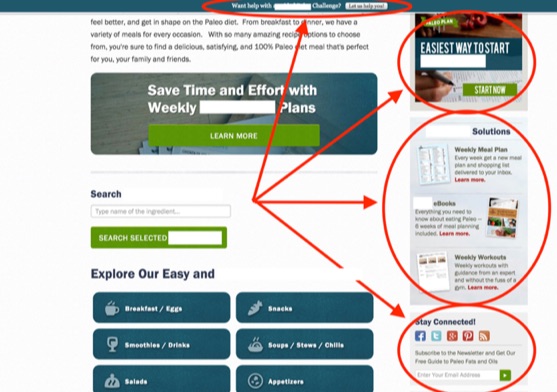
Split-test ninjas take-note: if you've read this far, and your opt-in rate is indeed garbage, there's ample opportunity to split test:
- Two versions of a homepage with different opt-in copy/design.
- Two versions of an exit-pop on a popular content piece.
Go nuts.
3. Traffic
If you're among the extremely lucky minority with list-to-sale conversions at-or-above 2%, and opt-in conversions at-or-above 10%, and you've raised your prices, I have some disappointing (although kind of good) news: split testing is not a good fit for your business.
Here's the question to ask: Are your monthly sessions at least 50% of your list size? (i.e. if your list has 2,000 subscribers, are you getting at least 1,000 uniques per month?) If not, you need a traffic strategy. Don't waste your time A/B testing anything.
While I'm a conversions expert and not a traffic expert, here's a quick decision tree:
- Determine your market size. If you could 5x your traffic, are there enough people in your market to support it?
- Implement a content/syndication/guest-post strategy ASAP. It's practically the only guaranteed winner across all verticals, but it can take up to a year to bear fruit.
- Consider hiring a paid traffic expert for one month to test customer acquisition costs from various paid sources. Choose the most profitable and double down while you wait for organic traffic to grow.
Bottom line: the same month spent split testing two opt-in offers on a homepage, landing page, or content page, could provide a 2-4x increase in revenue (by, say, improving an opt-in conversion rate from 1% to 4%), while the same time and money spent trying to boost an already maxed-out sales conversion rate would have a much smaller return.
That's why a little context can save you thousands.
About the Author: Nate Smith is a direct-response copywriter and funnel expert who helps businesses scale by exploiting their most powerful profit levers. Nate is founder of 8020MarketingGuy.com.
Miyerkules, Agosto 24, 2016
NAR Meets With MBA on Capital Standards
Stephanie Spear of NAR Government Affairs meets with a representative of the Mortgage Bankers Association to discuss capital standards and how regulatory issues could impact the availability of mortgage financing for commercial real estate.
